You are here
The Congressional Budget Office (CBO) recently released its analysis of the president’s fiscal year 2018 budget. Using its own economic and technical assumptions, CBO finds that the budget would not reach balance in 2027 as the administration projects — but instead the deficit would grow from $693 billion in 2017 to $720 billion in 2027. CBO estimates that nearly all of the difference between the administration and CBO arises because the administration projects “higher revenue collections — stemming mainly from a projection of faster economic growth.” While the president’s policies would reduce 10-year deficits from their current-law levels, the budget does not address the most significant drivers of our long-term debt — growing spending on Social Security and Medicare, combined with inadequate revenues.
Key findings from CBO’s report:
- Over the next 10 years, CBO predicts that the economy will grow by slightly less than 2.0% each year, on average. By contrast, the administration assumes that GDP will grow by slightly less than 3.0% each year, on average.
- The president’s proposals would reduce budget deficits by $3.3 trillion over the next 10 years, with spending cuts of $4.2 trillion that are partially offset by revenue reductions of $0.9 trillion.
- More than 85% of the president’s proposed spending cuts come from repealing the Affordable Care Act, making additional reductions to Medicaid, and cutting spending on non-defense discretionary programs.
- Although federal debt would be relatively constant over the next 10 years at approximately 80% of GDP, it would remain at a very high level historically — double its level over the past 50 years.
In coming years, our budget will be under enormous strain as the large baby boom generation retires, people continue to live longer, healthcare costs continue to outpace GDP growth, and our tax system is unable to keep up. The deficits that result from these pressures threaten our economy and our future. The president and Congress should work together to find durable, bipartisan solutions to our long-term fiscal challenges.
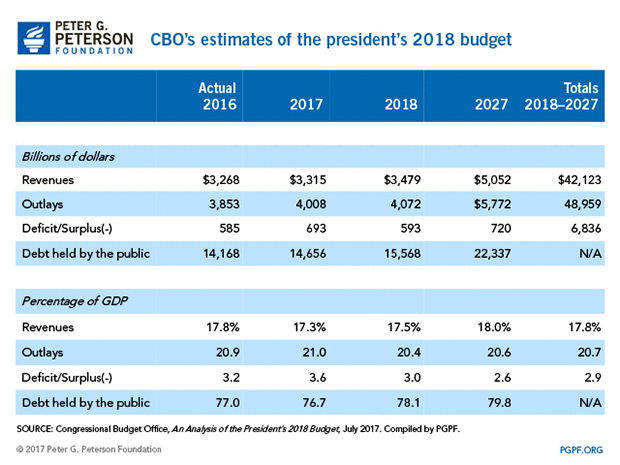
Economic assumptions. CBO estimates slower economic growth than the Administration projects. Over the next 10 years, the Administration assumes that GDP will grow, on average, by slightly less than 3.0% each year. By contrast, CBO predicts that the economy will grow, on average, by slightly less than 2.0% each year1.
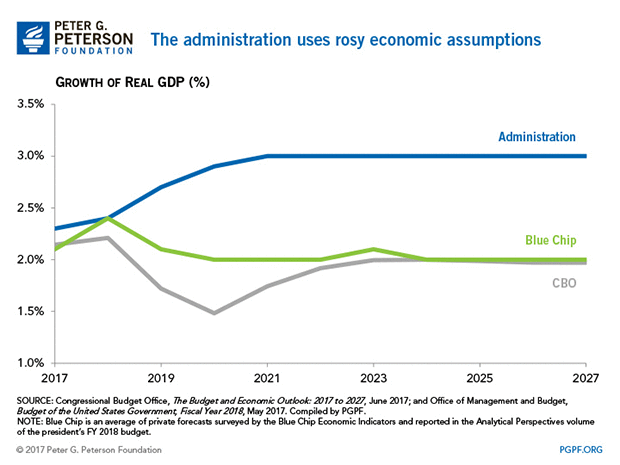
CBO’s economic projections are much more in line with private-sector forecasts. They are also more consistent with existing demographic trends, including the retirement of the baby boom generation, which will slow the growth of the labor force — and the economy — over the next ten years. Although the economy grew at a faster pace between 1960 and 1990 than what CBO now projects, economic growth during those earlier years was boosted by baby boomers and women entering the workforce. Baby boomers are now beginning to retire and the growth of women’s participation in the labor market has leveled off.
The budget will not reach balance by 2027. In May, the administration predicted that the president’s policies would produce a balanced budget by 2027. However, the administration’s optimistic economic assumptions are a significant driver of its projections about the budget deficit. Under more realistic economic assumptions, CBO estimates that deficits would grow from $693 billion in 2017 to $720 billion in 2027.
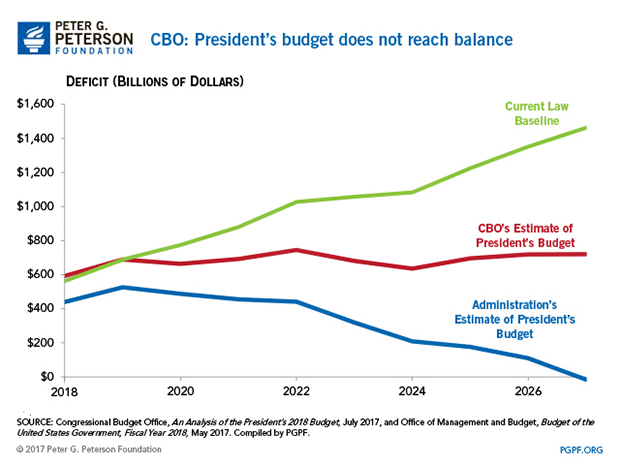
Debt will remain at historically high levels under the president’s budget. CBO estimates that federal debt would remain at approximately 80% of GDP in 2027. Historically, that is a very high level — double the average over the past 50 years. Since 1790, there have only been six years in which the debt was higher than it is today, and those were during and just after World War II. After the war, debt began to fall sharply as a share of GDP as the economy grew and some debt was paid down.
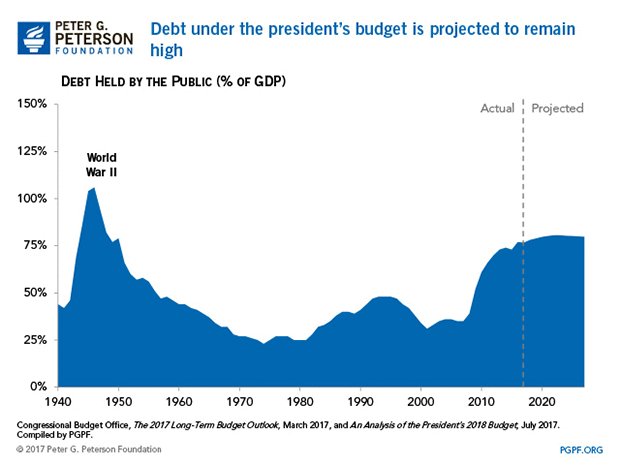
The president’s policies reduce revenues and spending. Over the next 10 years, the president’s budget would reduce spending by $4.2 trillion, while lowering revenues by $0.9 trillion. The revenue reductions stem from the proposed elimination of taxes that were imposed by the Affordable Care Act. The president also calls for a major overhaul of the tax system, but because the administration did not provide enough details about the reform, CBO was unable to score its costs or assess its effects.
The spending cuts are concentrated. More than 85% of the reductions come from repealing the Affordable Care Act, making additional reductions in Medicaid, and cutting spending on non-defense discretionary programs. These reductions will affect a wide range of programs for low- and middle-income families.
The president’s policies would push non-defense discretionary spending to historically low levels. Non-defense discretionary spending funds a wide range of governmental activities including education, infrastructure, R&D, homeland security, food safety, disaster assistance, environmental protection, public housing, federal law enforcement and the courts, and a host of other programs. Under the president’s budget, spending on those programs will decline from 3.2 percent of GDP in 2017 to 1.6 percent in 2027. At that level, non-defense discretionary spending would be more than 50 percent below its 20-year historical average.
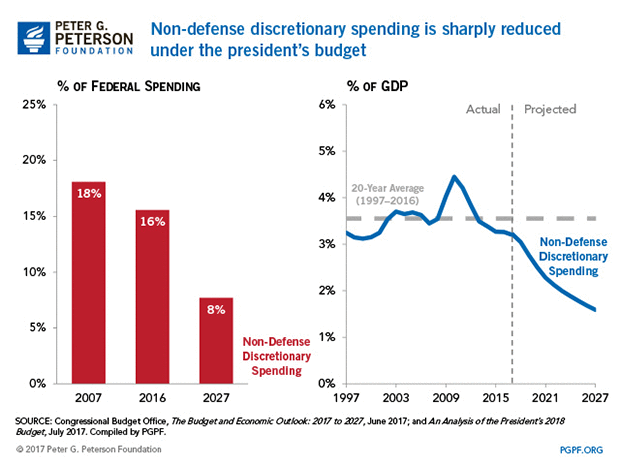
Long-term fiscal challenges remain. Addressing our long-term fiscal challenges is critical for ensuring that America has adequate resources for investing in our future, protecting critically important programs, and creating robust economic growth and opportunity for future generations. The president’s budget does not resolve these fundamental structural challenges. The president and Congress should work together and across party lines to find common ground in order to achieve durable policy solutions for the long-term fiscal health of the nation.
1 This growth figure includes CBO’s estimate of the economic effects of the president’s budget.
